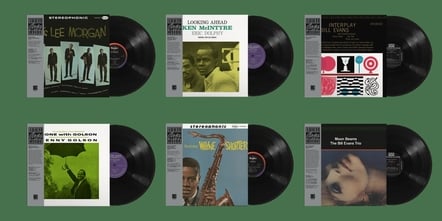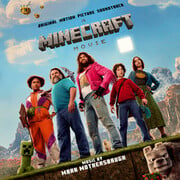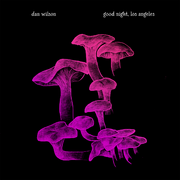New York, NY (Top40 Charts) Craft Recordings will reissue six records from Original Jazz Classics (OJC), the audiophile series celebrating critically lauded, fan-adored seminal jazz albums. The latest installment features newly remastered editions of Bill Evans' Interplay and Moon Beams, Lee Morgan's Here's Lee Morgan, Wayne Shorter's Introducing Wayne Shorter, Benny Golson's Gone With Golson, and Ken McIntyre & Eric Dolphy's Looking Ahead.
Spanning the late '50s through early '60s, these albums capture pivotal creative moments from some of the genre's most revered figures. The Lee
Morgan and Wayne Shorter titles mark the first titles from Vee Jay Records to be included in the Original Jazz Classics series. All six albums will drop between May 30 and July 25 and can be pre-ordered today.
Continuing OJC's commitment to quality, the reissues feature lacquers cut from the original stereo tapes (AAA) by
Kevin Gray at Cohearent Audio, 180-gram vinyl pressed at RTI, and tip-on jackets reproducing the original artwork. All titles will also be released digitally in 192/24 hi-res audio, launching alongside their physical counterparts and are available to pre-save today.
Bill Evans - Interplay (Available May 30, 2025)
A pianist's pianist, Bill Evans influenced countless jazz musicians after him, and his knack for warmly effervescent harmonies can be heard throughout Interplay. The album's title is telling: Evans was famous for nurturing interplay between his bandmates' instruments, and here, with a set predominantly of standards, he brought that to new heights in a quintet featuring trumpeter Freddie Hubbard and guitarist Jim Hall.
His fresh take on "When You Wish Upon a Star" is wistful, curious, and amorphous in all the right improvisational ways. Meanwhile, the quintet comes together satisfyingly on his sole original composition, the slyly swinging title track, "Interplay." Said AllMusic of this album, recorded in 1962, "Interplay stands as some of Bill Evans' most enigmatic and unusual music in makeup as well as execution."
Bill Evans Trio - Moon Beams (Available May 30, 2025)
In 1961, Bill Evans' prodigious bassist Scott LaFaro suddenly passed away at age 25 in a car accident. Moon Beams, a collection of ballads, is the first album Evans (who receive a posthumous GRAMMY Lifetime Achievement Award in 1994) released after nearly a year of grieving his departed friend. Chuck Israels stepped in on bass - with Paul Motian picking up again on drums - to incredibly moving, gorgeous effect. "It's a classic, a template for the future, a slice of pure genius," PopMatters wrote.
Tracks such as the somnambulant lament "In Love in Vain" and the introspective escapism of "Polka Dots and Moonbeams" are Evans' confident, clear-eyed tributes to the late LaFaro. To that end, Evans' evocative piano stands front-and-center with purpose in this quiet masterwork. Interestingly, singer-model Nico — later a tortured artist herself, who'd sing with the
Velvet Underground — graces this album's cover.
Lee
Morgan - Here's Lee
Morgan (Available June 27, 2025)
With Here's Lee Morgan, the jazz trumpeter (and acolyte of Clifford Brown) shows off the self-assurance and dexterity he previously nurtured as part of
Dizzy Gillespie's big band as a teenager, and later in Art Blakey's Jazz Messengers. Returning the favor, Blakey appears on Here's Lee Morgan, as part of this quintet, on drums. Original compositions such as the life-affirming jam "Terrible 'T'" and the effortlessly cool, upbeat "Mogie" would presage a career marked with commercial success, until Morgan's tragic murder in 1972 at a New York City jazz club.
Fifty-some years later, he's still considered one of the greats. "The music is good, solid hard bop that finds Lee
Morgan (already a veteran at age 21) coming out of the Clifford Brown tradition to display his own rapidly developing style," AllMusic wrote of Here's Lee Morgan. "Morgan's album could pass for a Jazz Messengers set."
Wayne Shorter - Introducing Wayne Shorter (Available June 27, 2025)
This debut album from Wayne Shorter features bassist Paul
Chambers and drummer Jimmy Cobb (aka Miles Davis' rhythm section), and those associations pay off richly. Despite Shorter's nascency as a bandleader, Introducing Wayne Shorter shines a light on the improviser's bright future. He'd just joined Art Blakey's Jazz Messengers, and five years later would spend several years as a part of Miles Davis' Second Great Quintet.
"This is rarified music that is immediately enjoyable," All About Jazz remarked. "It illuminates the sheer talent and genius of Wayne Shorter." Standouts include the epic upper "Down in the Depths," which feels like you're sitting in a live session, and Shorter's thrilling, breathless take on "Mack the Knife," a perennial favorite. Shorter would ultimately go on to win a dozen GRAMMYs, with the New York Times anointing him an "iconoclastic composer [who] has influenced generations of like-minded visionaries to push the boundaries of jazz."
Benny Golson - Gone With Golson (Available July 25, 2025)
By 1959, this Lionel Hampton and
Dizzy Gillespie alum was recording his fifth album, Gone With Golson. The future International Academy of Jazz Hall of Famer was a powerful presence on the saxophone, and this album shows off his prowess in top form. Tellingly, just after this release, he'd form the famed Jazztet with Art Farmer.
The swingy "Blues After Dark" is his most notable composition here, an after-work slice of life that's all about chilled-out vibes. Meanwhile, the nimble "Jam for Bobbie" stands out for its jolt of jazz-meets-blues. This is, AllMusic enthused, "a fine example of hard bop of the late '50s."
Ken McIntyre & Eric Dolphy - Looking Ahead (Available July 25, 2025)
Fresh from receiving his degree at the
Boston Conservatory, McIntyre released this, his first album, which finds him on the sax and flute. In contrast, Eric Dolphy (who here plays sax, flute, and bass clarinet) had already found fame in
Chico Hamilton's quintet and had just joined Charlie Mingus' Jazz Workshop. For many, this was an intriguing intersection between an avant-jazz newcomer (who'd go on to become a storied college-level music teacher), and a very skilled improviser who'd be name-checked as an influence by everyone from
John Coltrane to Frank Zappa.
To that end, there's a lot of proof-of-concept here. "Lautir" is a fascinating, lively, disharmonic excursion. It feels like a symbolic amuse-bouche to "Curtsy," the track that follows, which makes melodic sense of their frenetic, oddly entwined reeds. The duo then bring it all home with "They All Laughed," a delightful, invigorated cover of the Gershwin tune. As DownBeat cautioned at the time, "Don't dare listen to this record in a complacent mood."























